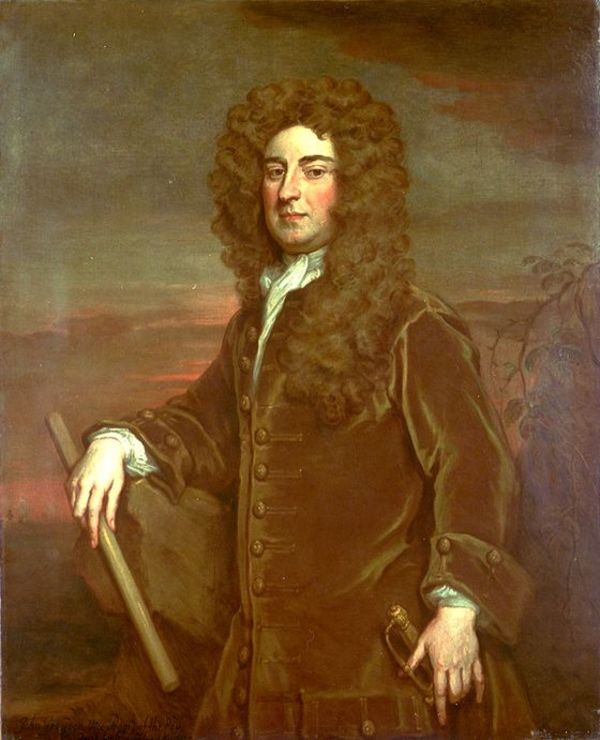
Source: Courtesy of Wikimedia Commons
GRAYDON, JOHN, vice-admiral; commodore of the Newfoundland convoy and temporary governor, 1701; b. c. 1666; d. 1726.
Graydon was appointed second lieutenant in 1686 and lieutenant two years later. Promoted captain in 1689 he was present at the battle off Beachy Head, 1690, and at Barfleur, 1692.
In 1701 Graydon, commanding the Assistance, was appointed commodore of the Newfoundland convoy and governor. The Newfoundland Act of 1699 had been drafted with a view to improving the lax and lawless state of affairs which had hitherto prevailed in that island. The act, which replaced the earlier Western Charters, gave judicial powers to the commodore and administrative powers to the fishing admirals of each harbour. The Board of Trade and Plantations wished to learn if the act had improved conditions. Graydon was instructed to investigate and report on the Heads of Enquiries with which he was supplied. His replies cover a wide field and are informative. He reported that the act was still largely disregarded by the fishing admirals, although the Lord’s day was duly observed. He described conditions in the fishing industry and the manner of livelihood of the inhabitants. Graydon reported that the French had better and more extensive fishing facilities than the English, that the garrison at Placentia (Plaisance) consisted of 3 companies of 30 men each, and that 60 guns had recently been landed. With Graydon went George Larkin, who was commissioned to report on an act for the suppression of piracy in the plantations.
After returning to England, Graydon was promoted to rear-admiral in 1702 and served under Admiral Sir George Rooke in the squadron supporting the landing of British troops and the assault on Vigo. Promoted vice-admiral in March 1702/3 Graydon was appointed to the command of a squadron with orders to sail to Jamaica without delay and there raise a force sufficient to attack and capture the French settlement at Placentia. On 18 March, off Ushant, a French squadron under Jean-Baptiste Ducasse was sighted, returning after an engagement with Vice-Admiral Benbow. In view of his orders Graydon did not attack and even recalled the Montague which had opened fire. This decision was to weigh heavily against him in the future.
At Jamaica the ships of his squadron were found to be in poor shape and he incurred the wrath of the merchants for impressing seamen from their service (as in fact he had the legal power to do). Many merchants wrote to the Board of Trade and Plantations to complain against what they considered illegal impressment and Graydon’s high-handed attitude [see Handasyde]. One writer described him as “moros and ill-tempered.” Despite obstruction Graydon managed to raise a force numerically superior to that of the French at Placentia. On arrival off Newfoundland, on 2 Aug. 1703, Graydon summoned a council of war on board the Boyne at St Mary’s Bay. Amongst the officers present were Rear-Admiral Sir William Whetstone and the military commander of the garrison at St John’s, Captain Michael Richards. In view of the crank and ill-found condition of the ships, much sickness amongst the seamen and troops, and rumours – possibly spread by French deserters – of a very strong force at Placentia it was decided that an attack might well meet with disaster. The squadron sailed for England without making any attempt at the reduction of Placentia. Richards, who had asked for permission to return on the grounds of ill health, embarked for the passage home, leaving Lieutenant Thomas Lloyd in command at St John’s.
On his return Graydon was faced with the extreme displeasure of the government and, from some quarters, with accusations of actual cowardice. His failure to attack Ducasse’s squadron, the angry protests of the merchants of Jamaica (who may have had “interest” at home), and his decision not to attack Placentia may have influenced the government against him. He was not brought to trial by court martial, but the House of Lords deprived him of his pension. He died in retirement, 12 March 1725/26.
A portrait of Graydon by Kneller hangs in the Painted Hall of the Royal Naval College, Greenwich.
PRO, Adra. 6/107; C.O. 194/2, 195/3. Campbell, Lives of the admirals, III. PRO, B.T. Journal, 1704–1708/9; CSP, Col., 1701, 1702, 1702–3, 1704–5. Charnock, Biographia navalis, II. DNB. Lounsbury, British fishery at Nfld.
Michael Godfrey, “GRAYDON, JOHN,” in Dictionary of Canadian Biography, vol. 2, University of Toronto/Université Laval, 2003–, accessed November 28, 2024, http://www.biographi.ca/en/bio/graydon_john_2E.html.
The citation above shows the format for footnotes and endnotes according to the Chicago manual of style (16th edition). Information to be used in other citation formats:
| Permalink: | http://www.biographi.ca/en/bio/graydon_john_2E.html |
| Author of Article: | Michael Godfrey |
| Title of Article: | GRAYDON, JOHN |
| Publication Name: | Dictionary of Canadian Biography, vol. 2 |
| Publisher: | University of Toronto/Université Laval |
| Year of publication: | 1969 |
| Year of revision: | 1982 |
| Access Date: | November 28, 2024 |